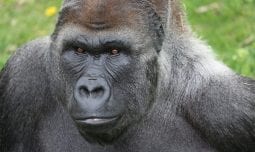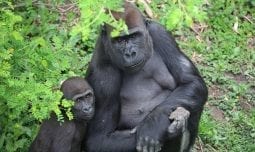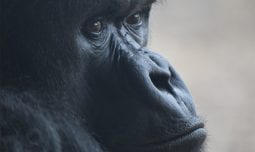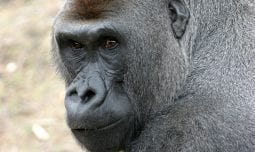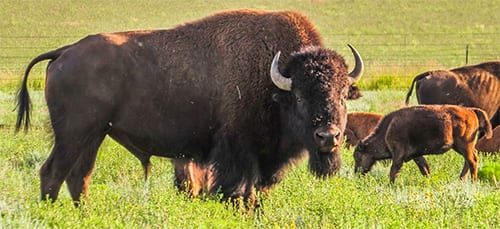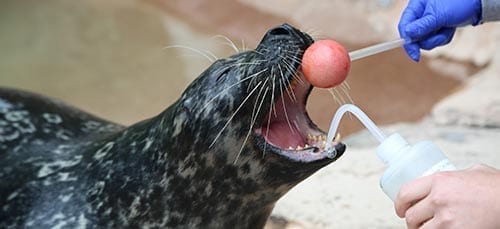Classification
Class Mammalia
Order Primates
Family Hominidae
Genus Gorilla
Species gorilla
Habitat & Range
Western lowland gorillas are widely distributed throughout the Congo Basin, inhabiting Angola, Gabon Cameroon, Republic of Congo, Central African Republic and Equatorial Guinea.
Inhabits a variety of moist, lowland forest types and swamps from sea level to about 8,000 feet (2,438 m).

Western Lowland Gorilla
Gorilla gorilla
Adaptations
- Primarily terrestrial, gorillas walk on all fours by curling their fingers under and walking on their knuckles, called knuckle walking.
- Communicates with over 20 vocalizations, including roars, grunts, whistles and barks.
- Opposable thumbs and big toes allow for climbing and grasping and manipulating objects.
- A bony sagittal crest on top of the head supports strong jaw muscles and teeth to grind coarse vegetation.
- Stomachs are larger than chests due to enlarged intestines needed to digest cellulose in plants.
- As diurnal animals (active during the daytime), gorillas rely on keen eyesight with excellent depth perception and color vision.
- Tufts of white hair on baby gorilla bottoms allow mothers to see them in the dense forest.
Physical Description
- Western lowland gorillas are four and a half to five and a half feet tall (1.4-1.75 m) when standing on their two legs.
- Males weigh 300 to 600 pounds (136-272 kg). Females weigh 150 to 300 pounds (113-136 kg).
- Skin is black and body hair is black with a brownish/grey tinge. Forehead is topped with a reddish/brown cap.
- Mature males, called silverbacks, have silvery-grey hair on their backs and thighs.
- Muscular arms are much longer than legs.
- Strong jaw muscles are attached to a bony ridge (sagittal crest) on the top of the head, especially large in mature males.
Diet
What Does It Eat?
In their historic range: Primarily herbivores that consume large quantities of leaves, roots, shoots, pith, bark and fruit. Water is primarily derived from vegetation.
At the zoo: Vegetables (including lots of celery), greens, browse, alfalfa, low starch biscuits and small amounts of fruit.
Predators
The only threat from a wild predator is the leopard. Gorillas are also hunted for bushmeat by humans.
Social Organization
Western lowland gorillas are non-aggressive, social great apes (group of primates including orangutans, chimpanzees and bonobos) living in family groups called troops. Troop size averages five to ten but can be up to 30 individuals. Family groups are made up of a dominate male silverback, several adult females, their offspring, and one or more sub-adult males called blackbacks. At sexual maturity males and females leave their natal troop to seek mates. Daily group activity is led by the silverback who also protects the group from intruders with intimating behavior such as vocalizations, chest beating and charging. At dusk, sleeping takes place in nests individually constructed of leaves and branches either on the ground or in trees.
Life Cycle
Life expectancy in the wild is 30 to 40 years and up to 60 years in human care. Males are sexually mature at 8 to 12 years, usually breeding at about 15 years. Females are sexually mature at 7 to 8 years, breeding between 10 and 11 years. Births are a single infant after gestation of 250-290 days. Infants weigh four to five pounds (1.8-2.3 kg). Infants are carried on their mom’s chest and back, crawl at about nine weeks and walk between three and six months. Young begin solid food around 6 months and are weaned between three and four years.
Collection Connection
Kali, Gunther and Mbeli. arrived from Zoo Atlanta in the summer of 2020. Young male gorillas often form bachelor groups after they leave their family units, and before they start families of their own. Denver Zoo has the animal care expertise and the facilities to provide exceptional care to this troop of males
Kal (male) born 10/31/2005
Gunther (male) born 7/6/2006
Mbeli (male) born 5/27/2002
Conservation Status
IUCN Status: Critically Endangered
Population losses are due to illegal hunting, disease and habitat loss. Increased conversion of the gorillas’ habitat to agriculture is expected to increase. Illegal hunting continues despite intense anti-poaching efforts.

Download the App!
Get the FREE Denver Zoo app today, and be a pro the next time you visit the Zoo. You’ll get access to the Zoo map, daily activities and schedules, animal facts, and more. You can even load your membership card onto the app for additional convenience. It puts everything you need for an amazing Zoo experience right into the palm of your hand!
